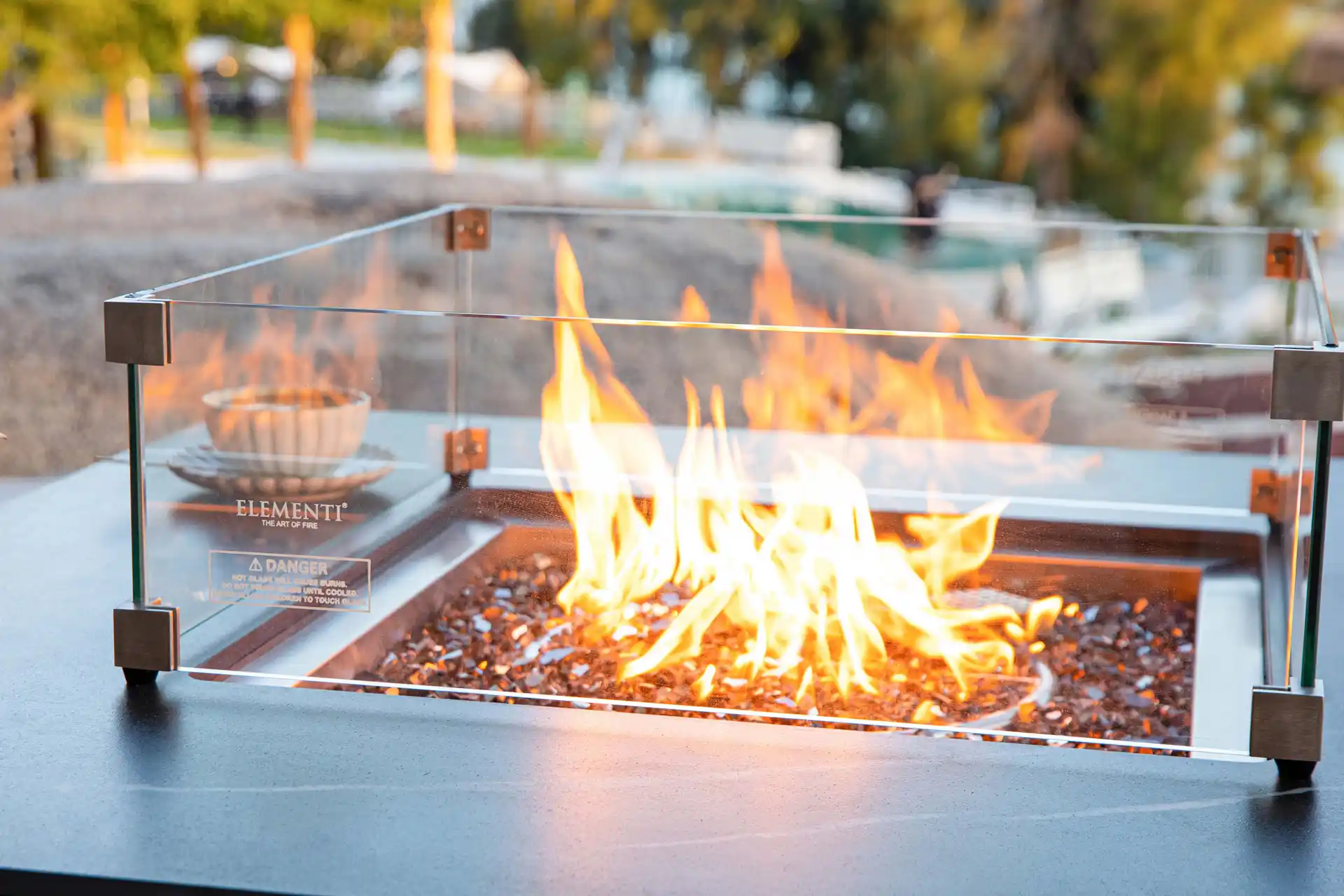1 🏡 Why does the garden need heating?
When the evenings get cooler, the garden, patio and balcony can remain cozy favorite places with the right heat source . To spend pleasant hours outdoors in spring, fall and on cool summer nights, many people use various heating solutions that combine warmth, light and atmosphere.
An outdoor heating system not only creates “temperature”, but also:
- longer outdoor season (from spring to fall),
- cozy atmosphere through light and flame pattern,
- a natural meeting place for family and friends.
2 🔥 Main categories of heating solutions for the garden
Garden heaters can basically be divided into four categories: open fires (fireplaces), electric heaters, decorative hybrid solutions and floor-integrated heating systems (patio underfloor heating).
2.1 Open fireplaces (real flame)
This category offers the most authentic ambience – real flames, natural light and perceptible radiant heat.
| Type | Features | Advantages | Suitable for |
|---|---|---|---|
| Gas fireplace | Propane or natural gas; adjustable flame | Smoke-free, clean, constant heat, high safety | Design terraces, gastronomy, families with a focus on comfort |
| Ethanol fireplace | Bioethanol as fuel; often compact | no exhaust fumes, low odor, no fixed installation necessary | Balconies, small areas, flexible use (indoors/outdoors) |
| Wood fire bowl / fire basket | Firing with firewood | classic campfire feeling, natural flame | Nature lovers, spacious gardens (with distance & ventilation) |
Note: Open flames require sufficient distance from furniture and plants as well as good ventilation.
2.2 Electric heaters (without flame)
Electric systems generate radiant heat – safe, low-maintenance and quickly available, but without a flame pattern.
| Type | Features | Advantages | Restrictions |
|---|---|---|---|
| Infrared radiant heater | ceiling/wall-mounted or on a stand | instant heat, precise, energy-efficient | no flame ambience |
| Electric mushroom heater / heating tower | free-standing, large radiation surface | wide range, simple operation | higher power consumption, sober design |
| Electric fireplace | simulated flames + warm air | safe, decorative, can also be used indoors | more decorative than primary heat source |
2.3 Decorative & hybrid solutions (focus on ambience)
Between pure heating and pure decoration: appliances with high design quality and moderate heat output.
| Type | Features | Advantages | Areas of application |
|---|---|---|---|
| Table fire (ethanol/gel) | compact, mobile, on table/sideboard | harmonious, safe, space-saving | balcony, dining table, lounge |
| LED flame light | Flame effect without heat | Can be combined with lighting concepts | interiors, showroom, decoration |
| Hybrid fireplace | Flame look + heating element | Ambience & useful heat in one | Hotel, gastronomy, modern terraces |
2.4 Floor-integrated heating systems (terrace underfloor heating)
Invisible, architecturally integrated solution: heating conductors or pipe systems under the decking provide even radiant heat from below – ideal for new builds or extensive renovations.
| Type | Features | Advantages | Restrictions |
|---|---|---|---|
| Electric terrace underfloor heating | Heating cables/mats under stone/tiles/planks | Even heat, “invisible”, smart control, can be combined with PV | Installation only makes sense during construction, higher initial investment |
| Hydraulic underfloor heating | Hot water circuit (heat pump/boiler) | High efficiency over large areas | Requires building services connection, less suitable for retrofitting |
Underfloor heating systems offer maximum comfort without visible appliances. However, they do not create a flame ambience and are primarily suitable for planning and construction phases.
3 🔥 Focus on the fireplace – types, shapes and materials
Now that we have learned about the various heating solutions for the garden, the fireplace itself takes center stage. It is more than just a source of heat – it creates atmosphere, combines design and function and often becomes the visual center of the garden.
3.1 🔥 Fuel types: wood or gas?
There are basically two main types of fireplaces based on fuel: Wood-burning fireplaces and gas fireplaces. Both produce real flames, but differ significantly in terms of operation, maintenance and effect.
| Type | Features | Advantages | To note |
|---|---|---|---|
| Wood fire pit | classic campfire with logs | natural flame, sound & smell, traditional experience | smoke & flying sparks, ash disposal, outdoors only |
| Gas fireplace | Propane or natural gas, adjustable flame | clean, safe, instant heat, no smoke | Gas cylinder or connection required, regular checks |
While wood-burning fireplaces beton emotion and naturalness, gas versions impress with their comfort, design variety and sustainability. Modern models – such as those from Elementi – are made of durable GFRC beton and offer an even, wind-stable flame.
Looking for more details? You can find the complete, practical comparison here: Gas vs. wood: Which type of fireplace is right for you?
3.2 🏺 Shapes & materials
Fireplaces differ not only in their fuel, but also in their design and the material used. Beton (GFRC) or stainless steel are particularly weatherproof and durable. Three main forms have become established:
- Fireplace – the classic model with open combustion chamber, versatile in size and style.
- Fire table – a combination of table and fireplace, ideal for lounge or dining areas.
- Fire bowl – a mobile, open bowl, perfect for spontaneous evenings in the garden.
Each shape offers a different experience – from the decorative lounge aesthetic to the rustic campfire feel. You can find out more in our detailed guides:
If you want to quickly compare the differences between these three variants, visit our comparison: 🔍 Fire pit, fire table or fire bowl – differences at a glance .
In addition to the shape, the material also plays a decisive role. Whether Beton or stainless steel – both materials offer different advantages in terms of durability, maintenance and design.
3.3 🛡️ Safety & application
Regardless of the type of fireplace, safety comes first. Fireplaces should be placed on a solid, non-flammable surface, at least one meter away from furniture or plants. Regular leak tests and CE-certified components are mandatory for gas models.
When used and maintained correctly, a fireplace offers years of comfort, warmth and atmospheric evenings – a real highlight for any outdoor area.
Whether you prefer the traditional wood fire or are looking for a modern gas solution – a well-designed fireplace brings warmth, light and style to your outdoor area and becomes the focal point of any social gathering.










